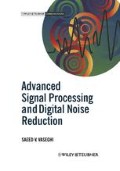Abstract
Signal processing is concerned with the identification, modelling, and utilisation of patterns and structures in a signal process. Signal processing methods plays a central role in information technology and digital telecommunication, in the efficient and optimal transmission, reception, and extraction of information. Stochastic signal processing theory provides the foundations for modelling the signals and the environments in which the signals propagate. Stochastic models are applied in signal processing, and in decision making systems, for extracting information from an observation signal which may be noisy, distorted or incomplete. This chapter begins with a definition of signals, and a brief introduction to various signal processing methodologies. We consider several key applications of digital signal processing in adaptive noise reduction, channel equalisation, pattern classification/recognition, audio signal coding, signal detection, and spatial processing for directional reception of signals. The chapter concludes with a study of the basic processes of sampling and digitisation of analog signals.
Access this chapter
Tax calculation will be finalised at checkout
Purchases are for personal use only
Preview
Unable to display preview. Download preview PDF.
Bibliography
Alexander S.T. (1986), Adaptive Signal Processing Theory and Applications. Springer-Verlag, New York.
Davenport W. B., Root W. L. (1958), An Introduction to the Theory of Random Signals and Noise. McGraw-Hill, New York.
Ephraim Y., (1992), Statistical Model Based Speech Enhancement Systems, Proc. IEEE, Vol. 80, No. 10, Pages 1526–1555.
Gauss K. G. (1963), Theory of Motion of Heavenly Bodies, Dover, New York.
Gallager R. G. (1968), Information Theory and Reliable Communication, Wiley, New York.
Haykin S. (1991), Adaptive Filter Theory, Prentice-Hall, Englewood Cliffs, N. J.
Haykin S. (1985), Array Signal Processing, Prentice Hall, Englewood Cliffs, N. J.
Kailath T. (1980), Linear Systems, Prentice Hall, Englewood Cliffs, N. J.
Kalman R. E. (1960), A New Approach to Linear Filtering and Prediction Problems, Trans, of the ASME, Series D, Journal of Basic Engineering, Vol. 82 Pages 35–45.
Kay S. M. (1993), Fundamentals of Statistical Signal Processing, Estimation Theory Prentice-Hall, Englewood Cliffs, N. J.
Lim J. S. (1983), Speech Enhancement, Prentice Hall, Englewood Cliffs, N. J.
Lucky R.W., Salz J., Weldon E.J (1968), Principles of Data Communications McGraw-Hill.
Kung S. Y. (1993), Digital Neural Networks, Prentice-Hall, Englewood Cliffs, N. J.
Marple S. L. (1987), Digital Spectral Analysis with Applications. Prentice Hall, Englewood Cliffs, N. J.
Oppenheim A. V., Schafer R. W. (1989), Discrete-Time Signal Processing, Prentice-Hall, Englewood Cliffs, N. J.
Proakis J. G., Rader C. M., Ling F., Nikias C. L. (1992), Advanced Signal Processing, Macmillan.
Rabiner L. R., Gold B. (1975), Theory and Applications of Digital Processing, Prentice-Hall, Englewood Cliffs, N. J.
Rabiner L. R., Schafer R. W. (1978), Digital Processing of Speech Signals, Prentice-Hall, Englewood Cliffs, N. J.
Scharf L.L. (1991), Statistical Signal Processing: Detection, Estimation, and Time Series Analysis, Addison Wesley, Reading, Massachusetts.
Therrien C. W.(1992), Discrete Random Signals and Statistical Signal Processing, Prentice-Hall, Englewood Cliffs, N. J.
Van-Trees H. L. (1971), Detection, Estimation and Modulation Theory, Parts I., II and III., Wiley, New York.
Shannon C. E. (1948),A Mathematical Theory of Communication, Bell Systems Tech. J., Vol. 27, pages 379–423, 623–656.
Wilsky A. S. (1979), Digital Signal Processing, Control and Estimation Theory: Poins of Tangency, Areas of Intersection and Parallel Directions, MIT Press.
Widrow B. (1975), Adaptive Noise Cancelling: Principles and Applications, Proc. IEEE, Vol. 63, Pages 1692–1716.
Wiener N. (1948), Extrapolation, Interpolation and Smoothing of Stationary Time Series, MIT Press Cambridge, Mass.
Wiener N. (1949), Cybernetics, MIT Press Cambridge, Mass.
Zadeh L. A., Desoer C. A. (1963), Linear System Theory: The State-Space Approach, McGraw-Hill.
Author information
Authors and Affiliations
Rights and permissions
Copyright information
© 1996 John Wiley & Sons Ltd. and B.G. Teubner
About this chapter
Cite this chapter
Vaseghi, S.V. (1996). Introduction. In: Advanced Signal Processing and Digital Noise Reduction. Vieweg+Teubner Verlag. https://doi.org/10.1007/978-3-322-92773-6_1
Download citation
DOI: https://doi.org/10.1007/978-3-322-92773-6_1
Publisher Name: Vieweg+Teubner Verlag
Print ISBN: 978-3-322-92774-3
Online ISBN: 978-3-322-92773-6
eBook Packages: Springer Book Archive

